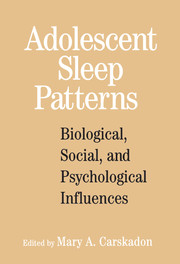Book contents
- Frontmatter
- Contents
- List of Contributors
- Foreword
- Preface
- Adolescent Sleep Patterns
- 1 Sleep and Adolescence: A Social Psychologist's Perspective
- 2 Factors Influencing Sleep Patterns of Adolescents
- 3 Endocrine Changes Associated with Puberty and Adolescence
- 4 Maturational Changes in Sleep-Wake Timing: Longitudinal Studies of the Circadian Activity Rhythm of a Diurnal Rodent
- 5 Nutrition and Circadian Activity Offset in Adolescent Rhesus Monkeys
- 6 Toward a Comparative Developmental Ecology of Human Sleep
- 7 Sleep Patterns of High School Students Living in São Paulo, Brazil
- 8 Sleep Patterns and Daytime Function in Adolescence: An Epidemiological Survey of an Italian High School Student Sample
- 9 Risks of Driving While Sleepy in Adolescents and Young Adults
- 10 What Can the Study of Work Scheduling Tell Us about Adolescent Sleep?
- 11 Accommodating the Sleep Patterns of Adolescents within Current Educational Structures: An Uncharted Path
- 12 Bridging the Gap between Research and Practice: What Will Adolescents' Sleep-Wake Patterns Look Like in the 21st Century?
- 13 Influence of Irregular Sleep Patterns on Waking Behavior
- 14 Stress and Sleep in Adolescence: A Clinical-Developmental Perspective
- 15 The Search for Vulnerability Signatures for Depression in High-Risk Adolescents: Mechanisms and Significance
- 16 The Regulation of Sleep-Arousal, Affect, and Attention in Adolescence: Some Questions and Speculations
- Index
- References
6 - Toward a Comparative Developmental Ecology of Human Sleep
Published online by Cambridge University Press: 22 September 2009
- Frontmatter
- Contents
- List of Contributors
- Foreword
- Preface
- Adolescent Sleep Patterns
- 1 Sleep and Adolescence: A Social Psychologist's Perspective
- 2 Factors Influencing Sleep Patterns of Adolescents
- 3 Endocrine Changes Associated with Puberty and Adolescence
- 4 Maturational Changes in Sleep-Wake Timing: Longitudinal Studies of the Circadian Activity Rhythm of a Diurnal Rodent
- 5 Nutrition and Circadian Activity Offset in Adolescent Rhesus Monkeys
- 6 Toward a Comparative Developmental Ecology of Human Sleep
- 7 Sleep Patterns of High School Students Living in São Paulo, Brazil
- 8 Sleep Patterns and Daytime Function in Adolescence: An Epidemiological Survey of an Italian High School Student Sample
- 9 Risks of Driving While Sleepy in Adolescents and Young Adults
- 10 What Can the Study of Work Scheduling Tell Us about Adolescent Sleep?
- 11 Accommodating the Sleep Patterns of Adolescents within Current Educational Structures: An Uncharted Path
- 12 Bridging the Gap between Research and Practice: What Will Adolescents' Sleep-Wake Patterns Look Like in the 21st Century?
- 13 Influence of Irregular Sleep Patterns on Waking Behavior
- 14 Stress and Sleep in Adolescence: A Clinical-Developmental Perspective
- 15 The Search for Vulnerability Signatures for Depression in High-Risk Adolescents: Mechanisms and Significance
- 16 The Regulation of Sleep-Arousal, Affect, and Attention in Adolescence: Some Questions and Speculations
- Index
- References
Summary
This exploratory comparative survey of the ecology of human sleep arises from a question posed by a pediatrician who studies mood disorders and sleep (Dahl, 1996; Dahl et al., 1996). In an attempt to gain insights into sleep regulation from ecological theory and research, he questioned what anthropologists know about sleep. The bald, if somewhat overstated, answer was: zero. Sleep, in its ubiquity, seeming nonsociality, apparent universality, and presumed biologically driven uniformity, has been overlooked as a background variable. Amazingly, it has not engaged a discipline dedicated to the study of human behavior, human diversity, and their cultural biological bases. A notable exception is the evolutionary-ethologically informed approach to the anthropological study of sleep pioneered by the work of McKenna and colleagues on sleep arrangements, infant state regulation, and risk for sudden infant death syndrome or SIDS (McKenna, 1991, 1992, 1996; Mosko, McKenna, Dickel, & Hunt, 1993). Harkness and Super have also documented cultural variation in infant sleep in relation to their studies of child care practices (Harkness & Super, 1996; Super, Harkness, van Tijen, van der Vlugt, Fintelman, & Kijksta, 1996), and scattered reports document sleep behavior (Ferreira de Souza Aguiar, Pereira da Sliva, & Margues, 1991).
- Type
- Chapter
- Information
- Adolescent Sleep PatternsBiological, Social, and Psychological Influences, pp. 69 - 117Publisher: Cambridge University PressPrint publication year: 2002
References
- 50
- Cited by

